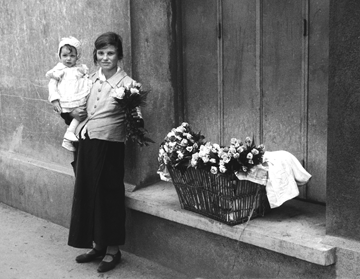By Phyllis Braff
When the Dresden-born photographer Fred Stein (1909-1967) bought his Leica in 1933, he saw the potential for the new, hand-held equipment to facilitate the recording of momentary effects. The purchase coincided with his move to Paris, where, until his departure for New York in 1941, he concentrated on the serendipitous discoveries of the street that seem so memorable.
The best of these photographs are actually quite complex. Interaction between figures provokes an emotional response that is more than matched by visual forces stemming from contrasts in illumination. These sensations call to mind the most avant-garde cinematography of the time.
Selling Flowers, Paris 1935
A “New York in the 1940’s” component to this two-decade overview underscores the dual impact of these pictures, which consistently weave their commonplace subjects into esthetically gripping compositions.
Stein practices his polished, sophisticated and highly artistic version of spontaneous snapshot esthetics in portraiture, too. Some of the celebrity sitters were friends from Europe and the era when he was active in intellectual circles. An image of Marc Chagall places the camera close to the floor, allowing the studio view to seem casual yet making the subject appear majestic.
Stein’s visual ambitions are summarized in “Sunday Afternoon,” a scene that combines the textures of nature, a distant crown of buildings, the deep shadows cast by a bridge and the ordinariness of strollers unaware of the camera.
Sag Harbor Picture Gallery, 66 Main Street, Sag Harbor. Through Dec. 15.
